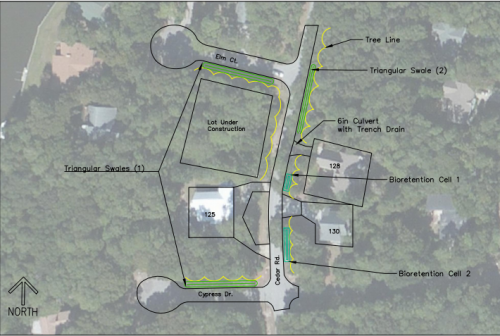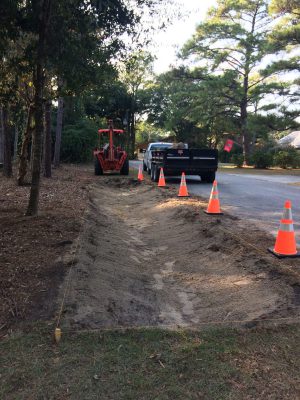PINE KNOLL SHORES –The town has broken ground on a natural stormwater management system designed to decrease the volume of runoff and alleviate some of the area’s flooding.
Through a partnership with the North Carolina Coastal Federation, the town is in the process of installing three swales, or long, shallow ditches along roadsides, and two bio-retention ponds in a neighborhood prone to flooding.
Supporter Spotlight
The installations are part of a broader set of tools known as best management practices, or BMPs, for stormwater, because of their ability to clean and move runoff.
The goal of the retrofits is to get the water off paved areas and onto the ground, where it has the chance to soak in. This decreases volume of stormwater runoff and filters out pollutants.
The systems are being installed on Elm Court, Cypress Drive and Cedar Road, streets also locally known as the “tree streets.” The area and the houses in it are prone to flooding, along with other parts of town. Town manager Brian Kramer said the project began two weeks ago and is expected to be completed by the spring.

In addition to causing flooding, stormwater can contain bacteria, sediments, chemicals and fertilizers it picks up as it moves. This problem is made worse by impervious surfaces, roads, sidewalks and driveways, that make the pollutants more likely to flow, unfiltered, into nearby waterways.
Lauren Kolodij, deputy director of the federation, said stormwater is the greatest pollutant of coastal creeks and sounds, leading to shellfish area closures and swimming advisories. She said that using best management practices reduces the amount of pollution, including sediment and bacteria, that reaches the water.
Supporter Spotlight
“If you reduce the volume and the flow of stormwater, none of those things can get to the water,” she said.
A Problem Rooted in History
Kramer said that Pine Knoll Shores, a community on Bogue Banks in Carteret County, has experienced flooding for decades. The problem, he said, began when the area was initially being developed with summer cottages built in the 1950s and 1960s and stormwater systems were not put in place.
“That may have been okay back then,” Kramer said, “but then we built a golf course and then we built a mobile home park and then we built a Hampton Inn.”
As the land became more developed, he said, the water had nowhere to go.

“It’s all caused, and everyone knows this, by development blocking the west-to-east flow of water to Hoop Pole Creek in Atlantic Beach and out to the sound,” Kramer said.
Over time, Kramer said, the east side of town, particularly, has dealt with the effects of flooding. He listed road closures and flooded garages and homes among the problems. Kramer said the town has tried a variety of solutions, including pumping stormwater directly into the ocean and Bogue Sound.
Kramer said the decision to work with the federation on this project was simple. The town was interested in finding methods of dealing with stormwater that were clean and effective.
“We want to have a town that’s environmentally friendly and focused,” he said.
Kramer said representatives from their local government went to Oak Island in Brunswick County to see similar systems the federation installed there and were encouraged by the results.
There has also been a push on the statewide level to address stormwater in recent decades. Bree Tillett, a coastal fellow at the federation, said that after fish kills from water pollution during Hurricane Floyd in 1999, the state government began to encourage the use of best management practices to improve water quality.
“The stormwater rules in the state require the use of BMPs for pretty much any development in the coastal plain,” she said.
A Green Solution
Tillett worked closely with the town and stormwater engineer Larry Sneeden, who also works for AECOM of Wilmingon, an engineering and consulting firm, to draw up plans for the BMPs.
Swales and bio-retention ponds are simple, which is what Kramer said he loves about them. Instead of focusing on reducing pollutants, the systems are designed to reduce stormwater volume, which also reduces the amount of pollutants that reach water bodies.
The swales in this project are 100 feet long. The shallow ditches move the water to bio-retention ponds while also allowing some water to infiltrate. Bio-retention ponds are holes where the water has a chance to sit, allowing it to seep slowly into the ground, filtering the water and keeping it from flooding the area. The town’s public works employees were able to create them without incurring the cost of outside contractors.
Sneeden said that the goal of the retrofits is to get water off of impermeable surfaces so water can soak into the ground, reducing the amount of stormwater runoff.
“They can seem more complicated than they really are but the key is just to give the water the opportunity to get off the pavement, the roads, the sidewalks, the driveways and get it to be able to travel over a grassed surface or vegetated surface and have a chance to soak in,” Sneeden said.
Tillett said the main goal of the retrofits may be to reduce the volume of stormwater, but that the water quality benefits are also impressive.
“Swales and bio-retention can reduce the amount of nitrogen, phosphorus, sediment over 75 percent,” she said.
Tillett was clear that the swales and bio-retention ponds were designed for 1.5-inch rainfalls, but not more than that. The retrofits offer a solution to make the situation better in a place with no stormwater system, she said, but they can’t work like systems used in newer developments.
“This is not the cure for cancer of their flooding problems,” she said, “but it will put a dent in it. You’re offering a chance for the water to enter somewhere where it can sit rather than moving over.”
Tillett said that if she saw less water moving between the houses, she would consider the project a success.
Sneeden said property owners can also do their part to lessen the amount of stormwater runoff in their communities. One example of this is to turn downspouts toward yards instead of pavement, like driveways.
“You can reduce the runoff coming off each lot, then you significantly reduce the runoff in the street that’s causing the flooding,” he said.
Other Communities
Kolodij said the federation is also in talks with town officials in Beaufort and Swansboro and has completed successful projects in Wrightsville Beach, as well as Oak Island.
One of the roles of the federation, she said, is to help communities apply for stormwater management grants and to connect towns with geographic information system, or GIS, specialists who can help them plan their retrofits.
“It’s giving local governments a jumpstart by providing them with the background data and the hydrographs so that they can then take that in put it in the template and create a plan,” Kolodij said.
She said there have been signs of great progress in completed projects, including a 50 to 90 percent decrease in stormwater from some BMPs in Wrightsville Beach.
For Kramer, the project has been a test bed. He hopes to demonstrate to the community the potential of technologies such as these. In the future, he said, the town would be interested in installing more.
“We’re really hopeful,” Kramer said, “that we’re going to see positive results from this next storm season.”







